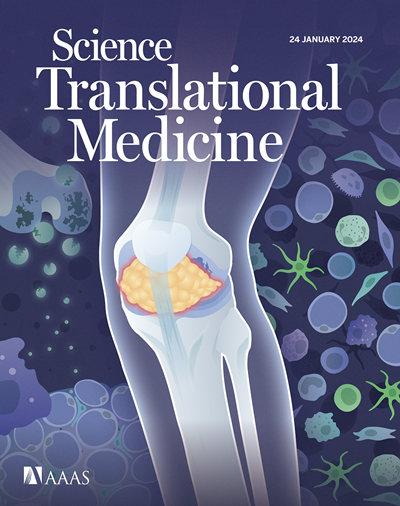Stress-induced eosinophil activation contributes to postoperative morbidity and mortality after lung resection
IF 14.6
1区 医学
Q1 CELL BIOLOGY
引用次数: 0
Abstract
Respiratory failure occurs more frequently after thoracic surgery than abdominal surgery. Although the etiology for this complication is frequently attributed to underlying lung disease present in patients undergoing thoracic surgery, this notion is often unfounded because many patients with normal preoperative pulmonary function often require prolonged oxygen supplementation even after minimal resection of lung tissue. Using a murine model of pulmonary resection and peripheral blood samples from patients undergoing resection of the lung or abdominal organs, we demonstrated that lung surgery initiates a proinflammatory loop that results in damage to the remaining lung tissue, noncardiogenic pulmonary edema, hypoxia, and even death. Specifically, we demonstrated that resection of murine lung tissue increased concentrations of the homeostatic cytokine interleukin-7, which led to local and systemic activation of type 2 innate lymphoid cells. This process activated lung-resident eosinophils and facilitated stress-induced eosinophil maturation in the bone marrow in a granulocyte-macrophage colony-stimulating factor–dependent manner, resulting in systemic eosinophilia in both mice and humans. Up-regulation of inducible nitric oxide synthase in lung-resident eosinophils led to tissue nitrosylation, pulmonary edema, hypoxia, and, at times, death. Disrupting this activation cascade at any stage ameliorated deleterious outcomes and improved survival after lung resection in the mouse model. Our data suggest that repurposing US Food and Drug Administration–approved eosinophil-targeting strategies may potentially offer a therapeutic intervention to improve outcomes for patients who require lung resection for benign or malignant etiology.
压力导致的嗜酸性粒细胞活化是肺切除术后发病率和死亡率的原因之一。
与腹部手术相比,胸部手术后呼吸衰竭的发生率更高。虽然这种并发症的病因经常被归结为接受胸部手术的患者存在潜在的肺部疾病,但这一观点往往是没有根据的,因为许多术前肺功能正常的患者即使在肺组织被微小切除后也经常需要长时间的氧气补充。我们利用肺切除小鼠模型和肺部或腹部器官切除患者的外周血样本证明,肺部手术会引发促炎循环,导致剩余肺组织受损、非心源性肺水肿、缺氧甚至死亡。具体来说,我们证明切除小鼠肺组织会增加同源细胞因子白细胞介素-7的浓度,从而导致局部和全身2型先天性淋巴细胞的活化。这一过程激活了肺驻留的嗜酸性粒细胞,并以粒细胞-巨噬细胞集落刺激因子依赖的方式促进了压力诱导的骨髓中嗜酸性粒细胞的成熟,从而导致小鼠和人类全身性嗜酸性粒细胞增多。肺驻留嗜酸性粒细胞中诱导型一氧化氮合酶的上调导致组织亚硝基化、肺水肿、缺氧,有时甚至导致死亡。在小鼠模型中,在任何阶段破坏这一活化级联都能改善有害结果,提高肺切除后的存活率。我们的数据表明,重新利用美国食品药品管理局批准的嗜酸性粒细胞靶向策略有可能提供一种治疗干预措施,改善因良性或恶性病因需要进行肺切除术的患者的预后。
本文章由计算机程序翻译,如有差异,请以英文原文为准。
求助全文
约1分钟内获得全文
求助全文
来源期刊

Science Translational Medicine
CELL BIOLOGY-MEDICINE, RESEARCH & EXPERIMENTAL
CiteScore
26.70
自引率
1.20%
发文量
309
审稿时长
1.7 months
期刊介绍:
Science Translational Medicine is an online journal that focuses on publishing research at the intersection of science, engineering, and medicine. The goal of the journal is to promote human health by providing a platform for researchers from various disciplines to communicate their latest advancements in biomedical, translational, and clinical research.
The journal aims to address the slow translation of scientific knowledge into effective treatments and health measures. It publishes articles that fill the knowledge gaps between preclinical research and medical applications, with a focus on accelerating the translation of knowledge into new ways of preventing, diagnosing, and treating human diseases.
The scope of Science Translational Medicine includes various areas such as cardiovascular disease, immunology/vaccines, metabolism/diabetes/obesity, neuroscience/neurology/psychiatry, cancer, infectious diseases, policy, behavior, bioengineering, chemical genomics/drug discovery, imaging, applied physical sciences, medical nanotechnology, drug delivery, biomarkers, gene therapy/regenerative medicine, toxicology and pharmacokinetics, data mining, cell culture, animal and human studies, medical informatics, and other interdisciplinary approaches to medicine.
The target audience of the journal includes researchers and management in academia, government, and the biotechnology and pharmaceutical industries. It is also relevant to physician scientists, regulators, policy makers, investors, business developers, and funding agencies.
 求助内容:
求助内容: 应助结果提醒方式:
应助结果提醒方式:


